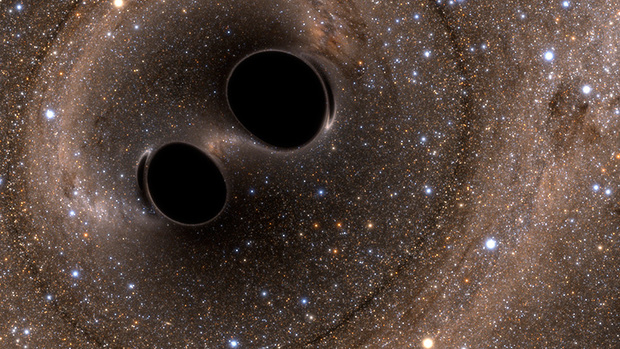
Black hole mergers are beautiful — and some of the most violent events in the cosmos. Here's how the process unfolds.
The story begins with two black holes orbiting far from each other in long, lazy circles. They could have been born as a binary pair of stars, or they may have just randomly encountered each other in the depths of interstellar space. Either way, to merge, they must get close, which means losing a lot of orbital energy.
The first step in stealing energy from the system is through the black holes' interaction with their environment. They are not alone — there are always thin wisps of gas and dust floating around, and sometimes there are even larger objects, like planets or stars. All of these objects interact through gravity with the black hole. Sometimes, they fall in, never to be seen again. Other times, they just barely miss, getting a little boost to their velocities and sapping some of the orbital energy from the black hole.
Once the black holes get close enough, another process takes over. The black holes stir space-time as they orbit each other, and this stirring releases gravitational waves that emanate from the pair like ripples in a pond. The gravitational waves are incredibly weak, however, and they start to seriously sap energy only when the black holes are very, very close together.
Related: How dancing black holes get close enough to merge
This has led astrophysicists to a conundrum called the "final parsec problem." Simulations have shown that gravitational interactions with the environment can bring black holes to within about a parsec (about 3.26 light-years) of each other in a decent amount of time. But within that distance, there simply isn't enough stuff to keep pulling away energy. On the other hand, at the same distance, the gravitational waves are far too weak and would take many multiples of the age of the universe to get the job done.
The final parsec problem is currently an unsolved riddle in astrophysics. But whatever mechanism takes place, eventually black holes get close enough that the gravitational waves can really pull a lot of energy from the system. At this point, the black holes have only a few seconds before they merge.
At these close distances, the black holes start to deform each other. They don't really have surfaces; the event horizons are invisible boundaries that mark the region of no escape. But the shape of the event horizon depends not just on the black hole itself but also the geometry of space-time around it. So, as the black holes begin their deadly dance, the event horizons elongate and stretch toward each other.
We understand what happens next only through complex computer simulations that monitor and track the evolution of the event horizons. In the milliseconds before impact, each black hole sends out a thin tendril — a tiny tunnel of its event horizon — toward its companion. These tendrils meet and merge, forming a bridge between the two black holes, as if they were connected by an umbilical cord.
Very quickly, the bridge widens and the event horizons glue together, like two colliding soap bubbles. Within an instant, the black holes merge into one.
What happens inside is anybody's guess. The center of a black hole is known as a singularity, a point of infinite density. This is where our current understanding of physics breaks down. Simulations show that the singularities quickly find each other, briefly orbit and then merge — but what actually happens is unclear.
Strangely, the newly merged black hole has a mass that's less than the combined masses of the original pair. For example, in 2016, the LIGO Scientific Collaboration detected the first gravitational wave event from merging black holes, discovering that a 36-solar-mass black hole had merged with a 30-solar-mass black hole to create a new one weighing only 63 solar masses.
What happened to the extra three solar masses? That mass got converted into energy in the form of gravitational waves. Someone had to pay for all the energy loss, and it came from the conversion of the black hole's mass itself. In every black hole merger, roughly 5% gets converted into gravitational waves.
For perspective, that's like converting three entire suns into pure energy. When black holes collide, they release more energy than every star in the universe — and all of it happens in complete, utter silence and darkness.







